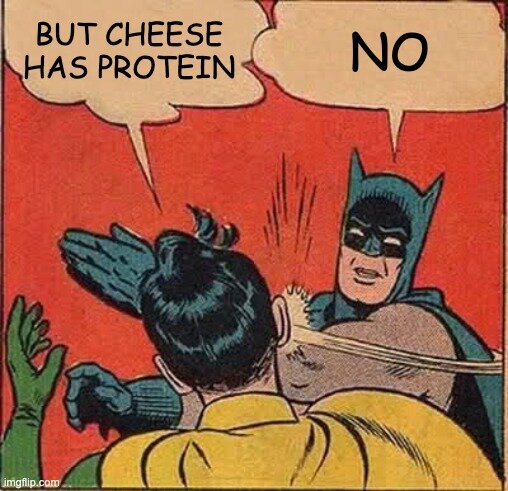stop complicating nutrition
^1.9/5 on clickbait scale
I write this in part because even after multiple nutrition classes, I don’t understand shit about it. There has never been a subject that so obviously screams “the more you learn, the less you know” than nutrition.
Without diving too deep into the wormhole, researching nutrition is challenging given the unlimited confounding variables that can bias a thesis (genetic and environmental differences, study duration, activity levels, sleep, microbiome status, etc.). We haven’t even identified every biochemical that exists in each food, let alone how they interact with each person’s genetic and gut biome differences, AND their ancestral history.
Point being, making a drastic change to your diet cause one of your friend’s watched “gamechangers” is a lot like getting investment advice from your uber driver.
So what should you focus on? Let’s prioritize.
Quantity
Quantity, in every sense of the word, is far more impactful than any granular details about anti-inflammatory ingredients or magic herbs.
Simply put, you can eat too much “good” food and still gain weight, while you can still lose weight eating just fast food if you limit the quantity (don’t try that).
Getting in control of your quantity can be hard, but there' are a couple quick tips that help
take or leave 20% off your plate
eat slower: that can mean salads instead of sandwiches, since they take longer to eat, eating with your left hand, or just deliberately slowing down
intermittent fasting: buzz word here, but fasting is a simple way to limit quantity. don’t worry about perfect timing, just fast 6-8 hours after waking and make sure your 2 meals are normal sized otherwise you’re missing the point.
add more whole fruits (except bananas) and veggies: both have lots of water and fiber, things that make you feel full
note on bananas: the lack of crunch and juice as you bite is telling. In other fruits, that crunch is fiber and the juice is mostly water (and sugar, but it’s ok) so a banana is essentially just more sugar and less water/fiber. They’re fine, but shouldn’t be your main source of fruit.
chug water: a full glass of water 15 min before a meal or snack will give you a moment to see how hungry you really are
Content
Once you’ve got a handle on quantity (or if that’s too hard) it’s time to focus on what you’re eating. If you can get 80% of your food throughout a week from these sources, you’re in good shape:
Lean protein: chicken, turkey, fish, eggs, some cuts of beef
cheese and peanut butter do not count, they are fat in sheep’s clothing
Veggies: greens, peppers, tomatoes, onions, etc.
limit potatoes and corn, as they are starchy
Fruits: apples, berries, pears, peaches, plums, necatarines, oranges, kiwis, pineapples, watermelon, etc.
but not fucking bananas
The other 20% can be spread as you like, whether that’s the occasional toast with breakfast, a banana, sandwich bread for lunch instead of a salad, or a dessert after dinner: you pick. Just build a mental pie chart, and keep it at 20% of your food or less.
In practice
What do these look like put together? Let’s come up with three examples.
The dessert guy:
disciplined but needs to end the day with sweets
Breakfast: 2-4 eggs, however you like, side of fruit
Lunch: lettuce or kale based salad with chicken or another source of lean protein
Snack: whole fruit (but not a fucking banana)
Dinner: chicken or other lean protein with a side of steamed broccoli, or same as lunch
Dessert: a quarter pint of ice cream topped with whipped cream
Yes, that’s right, if you eat that clean throughout the day you can reward yourself and still stay on track.
The “desserts not for me, but I need carbs to live” guy:
has to sprinkle their 20% more frequently
Breakfast: overnight oats, or eggs with 2 pieces of wheat toast
no bagels, they’re essentially just a dense, savory donut.
Lunch: Salad or a sandwich (ideally a healthy sandwich)
Snack: whole fruit (but not a fucking banana)
Dinner:
if a sandwich for lunch: lean protein + veggies + fruit
If salad for lunch: lean protein + veggies + starch (potatoes) or small bread
The “i need a glass of wine before bed” guy:
dangerous game to play, but doable
Same as dessert guy, but you replace the dessert with 1 glass of wine, maybe 2 if you really crushed it that day
Liquids
Liquids that aren’t water, coffee, or tea are empty calories. Alcohol at least serves a purpose, so if you drink ~responsibly~ and adjust for the calories by all means go off. But juice and soda have no place in an adult’s diet (aside from cocktails)
Juice is an extraction of the bad parts of fruit, leaving you with concentrated sugar water and no fiber.
chew fruit, don’t drink it
Soda’s only values are making alcohol taste better and getting stains out of clothing, not as a side at Sweetgreen
In conclusion
Eat less than you need to, whether its good or bad food
Get 80% of your food from lean protein, vegetables, and fruit
No juice or soda
Be patient
Can’t overstate this. The difference between a successful diet and an unsuccessful diet isn’t the diet, it’s consistency.
Questions? Send an email to ideen@vicesfitness.com





